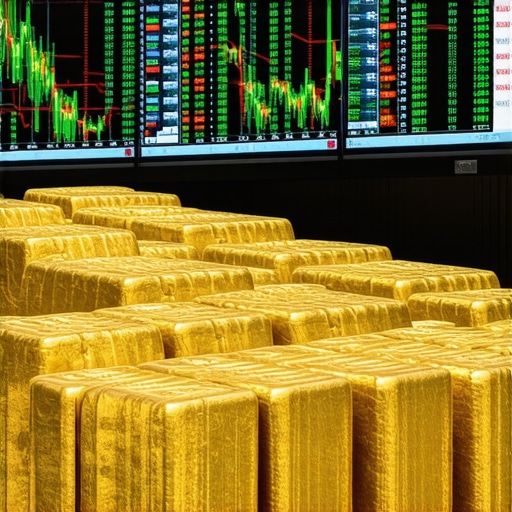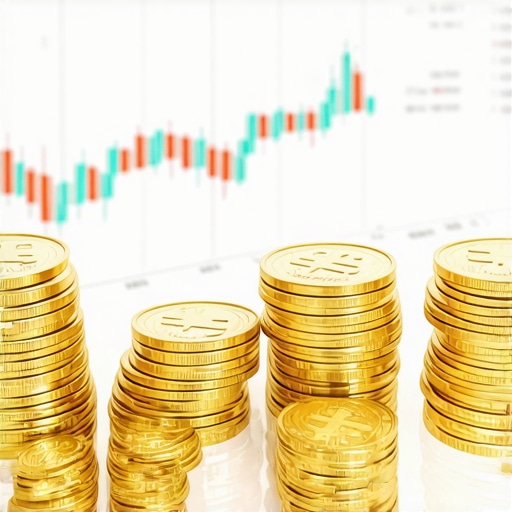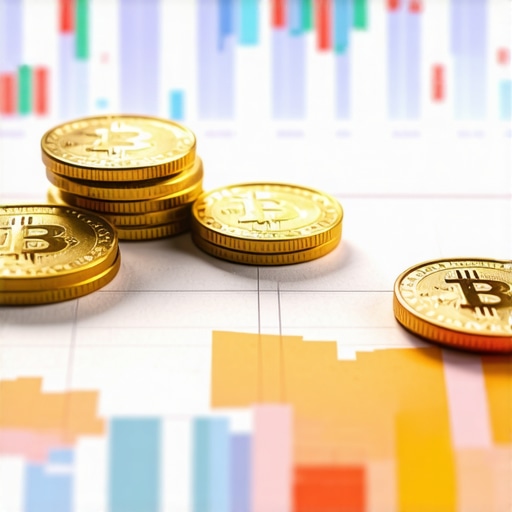Unveiling the Strategic Role of Central Bank Gold Purchases in 2025
As global financial markets evolve amidst geopolitical tensions and economic uncertainties, central banks are increasingly turning to gold as a cornerstone of their reserve assets. The surge in central bank gold purchases in 2025 is not merely a reflection of diversification but a deliberate strategy to influence market prices and hedge against systemic risks. This article explores the nuanced ways in which these acquisitions are shaping the gold market and what investors should anticipate in the coming year.
Deciphering the Market Mechanics: How Central Bank Purchases Influence Gold Prices
Central banks’ accumulation of gold directly impacts supply-demand dynamics, often leading to price appreciation. Historically, when these institutions increase their holdings, it signals confidence in gold’s role as a safe haven, thereby attracting institutional and retail investors. According to a detailed analysis by the IMF, central bank buying can serve as a stabilizing factor during volatile periods, but it can also trigger speculative surges if market participants interpret these moves as signals of upcoming price hikes.
Expert Perspectives: Will Central Bank Buying Drive Gold Prices to New Heights in 2025?
Leading analysts forecast that sustained central bank purchases will underpin a bullish trend in gold prices for 2025. The strategic accumulation by nations such as China and Russia, coupled with the de-dollarization efforts observed in multiple economies, are poised to elevate gold’s status. Moreover, the potential for increased inflationary pressures and currency devaluations amplifies gold’s appeal as an inflation hedge. For investors, understanding these macroeconomic undercurrents is critical in developing resilient portfolios, especially when considering diversified holdings in long-term gold investment strategies.
What are the Grey Areas? Could Central Bank Purchases Lead to Market Manipulation?
While central bank activity can signal confidence, some market participants worry about potential manipulation or coordinated actions to artificially inflate gold prices. Transparency issues and varied reporting standards pose challenges in fully assessing these moves. Investors should approach with a nuanced understanding, integrating technical analysis and geopolitical risk assessments, as outlined in market forecasts for 2025.
To deepen your understanding of how to leverage these trends, explore our comprehensive beginners’ guide to safe gold investing and stay ahead of market shifts. Engaging with expert insights and evolving strategies will be essential for navigating the complex landscape of gold investments in 2025.
Decoding the Impact of Macro Trends on Gold’s Long-Term Value
As we venture further into 2025, understanding the macroeconomic landscape becomes essential for gold investors. Central bank gold purchases are just one piece of a complex puzzle involving inflation rates, currency fluctuations, geopolitical tensions, and technological innovations. For instance, the rising adoption of digital currencies and shifts in monetary policy could significantly influence gold’s role as a safe haven. A comprehensive analysis by the market analysts predicts that these macro factors will be critical in shaping gold’s trajectory throughout the year.
How Do Supply Chain Disruptions Affect Gold Prices in 2025?
Supply chain disruptions, whether caused by geopolitical conflicts, pandemic aftershocks, or logistical issues, can cause fluctuations in gold availability and pricing. The extraction and refining processes are intricately linked to global supply chains, and any disturbance can lead to short-term spikes in gold prices. Experts recommend monitoring these disruptions closely, especially in regions vital to gold mining and refining, such as Africa and Southeast Asia. Additionally, innovations in mining technology and recycling processes could mitigate some supply risks, offering new investment avenues in the gold sector.
What are the Emerging Investment Strategies for Gold in 2025?
Advanced investors are increasingly utilizing a range of strategies, including gold ETFs, futures contracts, and physical holdings, to hedge against inflation and economic instability. Developing a diversified approach—combining physical gold with financial instruments—can optimize returns and manage risks effectively. For example, integrating a long-term gold portfolio with tactical trading through options or futures can provide flexibility amidst volatile markets. Keeping abreast of emerging trends, such as gold-backed cryptocurrencies, can also open innovative investment channels in 2025.
Are Gold Prices Prone to Sudden Shocks or Are They Predictable?
While many analysts believe that macroeconomic indicators can forecast gold trends, unexpected geopolitical events or sudden shifts in monetary policy can still trigger rapid price changes. The inherent volatility of gold markets necessitates a nuanced understanding of both technical and fundamental analysis tools. As highlighted by the market experts, employing a combination of trend analysis, sentiment gauges, and geopolitical risk assessments can help investors navigate unpredictable shocks effectively.
If you want to deepen your understanding of how to adapt your investment strategies to these dynamic conditions, consider exploring our detailed guides on selecting reputable gold dealers and safeguarding your holdings. Staying informed and adaptable will be the cornerstone of successful gold investing in 2025.
Understanding the Interplay Between Central Bank Gold Purchases and Market Stability
Central banks’ strategic accumulation of gold in 2025 is not merely about diversification; it is a calculated move aimed at reinforcing financial resilience amid global uncertainties. These acquisitions influence market prices through supply-demand dynamics, often signaling confidence in gold’s safe haven status. However, the opacity surrounding some central bank transactions raises questions about potential market manipulation. Researchers such as the IMF have emphasized that transparency in these activities is crucial for market integrity, as detailed in their 2023 report “The Role of Gold in Global Reserves”.
Advanced Analytical Frameworks for Predicting Gold Price Trajectories in 2025
Investors seeking to navigate the complexities of gold price movements should leverage sophisticated analytical tools that incorporate macroeconomic indicators, geopolitical developments, and technical signals. The integration of machine learning algorithms with traditional fundamental analysis can enhance predictive accuracy. For instance, models that factor in currency devaluations, inflation expectations, and global political events can provide a nuanced outlook. As per a recent study by market analysts at GoldCore, predictive analytics are increasingly vital in managing the inherent volatility of gold markets, especially during periods of rapid geopolitical shifts “Gold Price Forecasts for 2025”.
What are the implications of emerging geopolitical tensions on gold’s role as a safe haven?
Rising geopolitical tensions, such as conflicts in key regions or trade disputes, tend to heighten demand for gold as a hedge against systemic risks. The nuanced understanding of these tensions requires investors to monitor not just headline news but also underlying power dynamics and diplomatic shifts. As highlighted in the research by the Council on Foreign Relations, the escalation of regional conflicts often correlates with short-term spikes in gold prices, emphasizing the importance of geopolitical risk assessment in investment strategies.
For those eager to deepen their expertise, exploring comprehensive guides on geopolitical risk management and portfolio hedging techniques is recommended. Engaging with expert commentary and real-time data analysis will be crucial for staying ahead in this dynamic environment.
The Role of Supply Chain Resilience in Sustaining Gold Market Stability
Supply chain disruptions remain a critical factor influencing gold availability and pricing. Particularly in regions like Africa and Southeast Asia, where mining and refining are vital, disruptions caused by political instability, pandemics, or logistical bottlenecks can trigger price volatility. Innovative solutions—including advances in mining technology, recycling, and supply chain diversification—are essential to mitigate these risks. The integration of blockchain technology for traceability and transparency in gold supply chains represents a promising frontier, as discussed in recent industry reports “Innovations in Gold Supply Chain Management”.
Emerging Investment Strategies in Gold: From Traditional to Tech-Driven Approaches
Modern investors are increasingly adopting hybrid strategies that combine physical gold holdings with financial instruments like ETFs, futures, and digital assets such as gold-backed cryptocurrencies. This diversification aims to hedge against inflation, currency devaluation, and market volatility. For example, leveraging gold options can provide tactical flexibility, enabling investors to capitalize on short-term price swings. As the market evolves, understanding the nuances of these instruments becomes essential. Resources like our detailed guides on developing resilient gold portfolios can offer valuable insights into optimizing investment outcomes in 2025.
Can algorithmic trading and AI-driven analysis revolutionize gold investment strategies?
Absolutely. The advent of AI and machine learning in trading platforms has transformed how investors interpret market signals and execute trades. These technologies can analyze vast datasets, identify subtle patterns, and predict price movements with higher precision. According to industry experts at the World Gold Council, integrating AI into gold trading strategies enhances responsiveness and risk management, especially during unpredictable geopolitical or macroeconomic shocks. Staying informed about technological advancements and adopting innovative tools will be vital for achieving a competitive edge in gold investing.
To explore these advanced strategies further, consider engaging with specialized resources, webinars, and expert analyses tailored to high-level investors seeking to navigate the complex gold market landscape in 2025.
Unraveling the Impact of Digital Currencies on Gold’s Safe Haven Status
As the financial landscape evolves with the rise of digital currencies, including central bank digital currencies (CBDCs) and cryptocurrencies, the traditional role of gold as a safe haven is being redefined. Experts argue that digital assets may complement or challenge gold’s position, depending on regulatory developments and technological adoption. According to a comprehensive report by the Federal Reserve, the integration of digital currencies into the monetary system could either dilute or reinforce gold’s appeal, contingent upon how these assets coexist in the financial ecosystem.
How Will Environmental, Social, and Governance (ESG) Factors Influence Gold Mining in 2025?
The increasing emphasis on ESG criteria is transforming how gold mining companies operate and report. Investors are scrutinizing environmental sustainability, social responsibility, and governance practices more than ever before. Companies adopting greener extraction methods and transparent supply chains are gaining favor, which could influence gold prices by affecting supply dynamics. Industry insights from the World Gold Council emphasize that responsible mining practices are now integral to long-term valuation and investor confidence in the gold sector.
What are the Risks and Opportunities in Gold-Backed Blockchain Technologies?
The emergence of blockchain-based gold tokens and digital certificates presents a paradigm shift in gold investment. These innovations promise increased liquidity, transparency, and fractional ownership, but also pose regulatory and security challenges. Pioneering projects like the GoldToken exemplify how blockchain can revolutionize gold trading and custody. As this technology matures, investors must evaluate the credibility and security protocols of these platforms to harness their full potential.
Engage with our expert-led webinars and advanced guides to explore how integrating blockchain solutions can diversify and fortify your gold investment strategy in 2025.
Exploring the Role of Macro-Economic Shifts in Gold Price Volatility
Major macroeconomic variables such as inflation rates, interest rate policies, and geopolitical tensions continue to exert profound influence on gold prices. The coordinated monetary tightening by central banks globally may temporarily suppress gold’s appeal, but sustained inflationary pressures could lead to substantial rallies. The IMF highlights that macroeconomic stability remains a critical determinant of gold’s long-term value, urging investors to adopt dynamic risk management frameworks that respond to shifting economic indicators.
The Strategic Significance of Geopolitical Risks in Gold Portfolio Diversification
Increasing geopolitical tensions, such as trade conflicts and regional conflicts, elevate the importance of gold in diversified portfolios. Gold’s inert nature makes it a preferred hedge against systemic risks, but understanding the geopolitical landscape requires sophisticated analysis of diplomatic developments, military conflicts, and international sanctions. As research from the Council on Foreign Relations suggests, proactive geopolitical risk assessment can help investors anticipate price movements and adjust their holdings accordingly.
Conclusion: Embracing Multi-Dimensional Strategies for 2025
In an era marked by rapid technological innovation, geopolitical upheavals, and evolving monetary policies, a multi-faceted approach to gold investment will be essential. Combining traditional physical holdings with cutting-edge digital and blockchain solutions, while maintaining vigilant macroeconomic and geopolitical analysis, will position savvy investors to capitalize on emerging opportunities and mitigate risks. To stay at the forefront of these developments, explore our comprehensive resources and engage with expert insights designed for high-level investors aiming to master the complexities of gold markets in 2025.
Expert Insights & Advanced Considerations
1. Strategic Diversification Remains Crucial
Top analysts emphasize that central bank gold acquisitions in 2025 are part of a broader diversification strategy to mitigate systemic risks and hedge against currency devaluation, highlighting the importance of integrating gold within a resilient portfolio.
2. Transparency and Market Stability
Experts advocate for increased transparency in central bank transactions to prevent market manipulation and ensure stability, recommending investors stay informed through authoritative reports such as those from the IMF.
3. Technological Innovation and Supply Chain Resilience
Advancements in mining technology and blockchain are transforming supply chain management, reducing risks associated with disruptions, and opening new avenues for secure gold investments.
4. Macro-Economic Indicators as Predictive Tools
Utilizing sophisticated analytical frameworks that incorporate macroeconomic variables can enhance prediction accuracy of gold price movements, enabling strategic entry and exit points.
5. Impact of Digital Currencies
The rise of digital currencies presents both challenges and opportunities for gold’s safe haven status, requiring investors to adapt to evolving financial ecosystems and regulatory landscapes.
Curated Expert Resources
- IMF Reports on Gold Reserves: Authoritative insights into central bank activities and market implications, essential for understanding global reserve strategies.
- World Gold Council Publications: In-depth research on gold demand, supply dynamics, and ESG factors influencing the gold sector.
- Market Analysis Platforms (e.g., GoldCore): Advanced predictive analytics and trend forecasts for 2025, supporting data-driven decision-making.
- Blockchain and Supply Chain Innovations: Industry reports on technological advancements improving transparency and security in gold trading.
- Macroeconomic and Geopolitical Analytical Tools: Resources for assessing global risks impacting gold prices and strategic allocation.
Final Expert Perspective
Understanding the intricate interplay between central bank gold purchases and market stability is essential for sophisticated investors aiming to capitalize on 2025 trends. Embracing innovative technologies, maintaining transparency, and leveraging macroeconomic insights will distinguish successful strategies. I invite you to deepen your expertise by engaging with these resources and sharing your insights—together, we can navigate the complexities of gold markets with confidence and precision.










This post offers a comprehensive overview of the factors influencing gold prices in 2025, especially highlighting the strategic role of central bank purchases. From my experience in gold investing, I’ve noticed that while central bank actions often lead to short-term price spikes, the underlying macroeconomic trends—like inflation expectations and geopolitical stability—tend to drive longer-term value. I am curious about how emerging technologies like blockchain might further increase transparency in these transactions and possibly reduce market manipulation concerns. Has anyone seen successful implementations of such innovations in real-world central bank operations or private markets? Understanding how these tools evolve could be crucial for making more informed investment decisions amidst increasing market complexity.